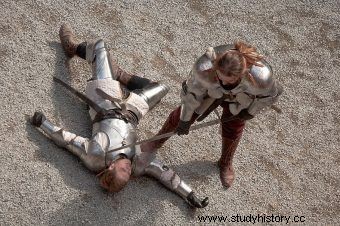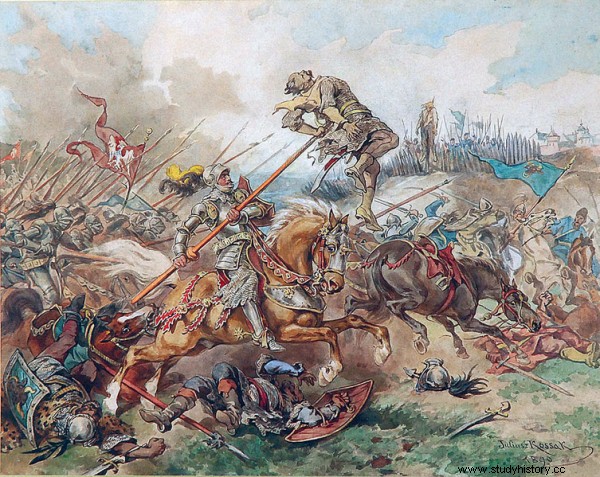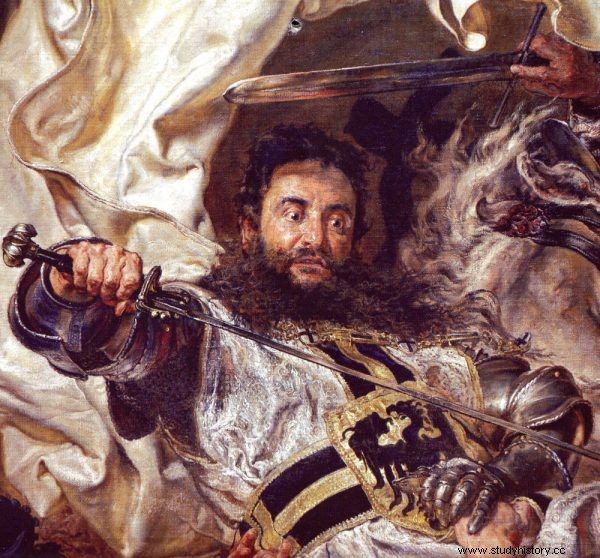Every war, every battle brings victims. Nowadays, they are no longer anonymous and we are able to determine who and where died, and even who was the perpetrator. In the past, things were quite different. The chronicles usually report the fallen from whom noble blood has escaped. Sometimes they also remember those who shed this blood on them. The rest of the anonymous victims forever remained a part of historians' mathematical arguments - whether the losses of the fighting parties were "heavy" or whether they all died.
The Middle Ages are no different with their battles. It should be emphasized, however, that contrary to popular belief, battles in the Middle Ages were not common. It was extremely costly to equip and maintain an army, so it was more profitable to avoid major confrontations. The peculiar prudence of the strategists of the time demanded that the war should be waged on economic exhaustion. It was about the fastest possible profits at minimal cost.

Killing an important enemy in battle brought fame and fortune.
However, when the repertoire of marches, looting, looting and dodging was exhausted, the brutality of the then battlefield was often far from the lofty slogans of the chivalrous ethos.
Medieval knightly ethos
In history, there are even specific cases of battles in which the knights did not spare not only the low-born (which was the norm), but also did not give pardon to even the most eminent dignitaries of the opposing side. What's more - it happened that even before the arms were crossed, it was planned to kill a specific person. This was the case in 1214 at Bouvines, where Emperor Otto IV himself and his allies swore to kill the French king Philip II Augustus - which they ultimately failed. In the battle of Durnkrüt in 1278, the king of Bohemia, Přemysl II Ottokar, knocked off his horse, ruthlessly killed several German knights against knightly ethics.

Medieval battles are not only honorary duels, but also pogroms of opponents. Juliusz Kossak - "Cherubin Gniewosz in the Battle of Suceava 1497"
An interesting case was another of the Czech rulers - John of Luxembourg. Being a blind man, he ordered himself to fight at Crécy in 1346. Of course, he did not come out alive. In turn, in the war of the Two Roses, the fighting parties, having put aside their noble ideals, eagerly killed each other's commanders. King Richard III himself left this world at the Battle of Bosworth in 1485 with twelve wounds from swords or axes. Even in principle, knightly battles, initially conducted in a truly tournament style, such as the one near Koronowo in 1410, could turn into a real shambles with a hecatomb of dignified victims.
Who killed the Grand Master?
It was no different at Grunwald, where most religious dignitaries laid their heads (203 out of 250 taking part in the battle). The ferociousness of the fight is evidenced by the fact that none of the Order's elders surrendered to any of the Jagiellonian knights. The dignitaries, with the exception of a few fugitives, fell on the battlefield. Among them was Grand Master Ulryk von Jungingen . The very fact of his death in the light of the above-mentioned examples of merciless battles for the eminent heads does not seem to be anything special, but for a long time the historians' discussions have raised the question - who killed the great master?
The lack of such information in the Grunwald records should come as no surprise to anyone, as it usually seems to be a generally accepted practice in contemporary chronicles. And even when the personal details of the perpetrator of the death of a dignitary were known, there were either several versions of the names (as in the case of Peter Basilimi alias John Sabroz alias Bertran de Gurdun, who killed Richard the Lionheart), or as Miloš Obilić - the killer of Sultan Murad I in Kosovo Pole - turns out to be a semi-legendary character.

The death of Ulrich von Jungingen in the painting by Jan Matejko.
As for Grunwald, it is known that at the critical moment of the battle, Ulryk led 16 reserve banners into battle, which , while moving against the king, encountered our [Poland] great banner and bravely collided with it with spears . And in the first clash, the master, marshal, commander of the entire Teutonic Order were killed . In the old historiography reproduced by fiction and film, the killing of the master was attributed to plebeian walkers. In the light of later research, this view was completely rejected, as there is no evidence of infantry in this battle in any sources.
The merit of killing a grand master was also attributed to some lad, i.e. a simple soldier, e.g. a squire or a post office from the vicinity of one of the fighting knights. However, the desire to personalize the hero of the Battle of Grunwald forced us to look further. Nobody expected, however, that the search would definitely end ... Russia's ambassador to NATO, Dmitry Rogozin. The Russian stated that it was his ancestor Stefan Mitkiewicz from the Smolensk regiments who killed Ulryk. However, since he did not provide any evidence for this, none of the prospectors took his story seriously.
Mszczuj z Skrzyńska
The most widely accepted hypothesis today is that von Jungingen died at the hands of Mszczuj from Skrzyńsk. There are many reasons for his candidacy. It was his squire, Jurga, who stripped the corpses on the battlefield, tore the precious reliquary from the neck of one of them and handed it over to his master. Knowing who the pectoral belonged to, he handed it over to the king as proof of the death of the great master. Interestingly, however - Mszczuj only informed about the death of Ulryk, but did not say directly that it was his work.
Yes, as a guardian of the court banner, which fought against the Teutonic Order's reserve, he could victoriously combine arms with a grand master, but there is no unequivocal proof. Doubts, however, seem to multiply. For when Jagiełło ordered the identification of the body of his adversary, he did not entrust this task to Mszczuj or his squire, but ... to Stanisław of Bolemin, a captain of the Grand Master, who was taken prisoner.
Perhaps the king did not trust his knight (!), or perhaps Mszczuj did not even know who and where he defeated. And it is not at all unlikely. The battle confusion and the fight in the narrow column formation in which the Grunwald battle was conducted favored this turn of events. The lack of space and time to fight the usual duel with the opponent's challenge can only confirm the anonymity of the winning grandmaster.

Meeting of Władysław Jagiełło with Mikołaj Pała in Taczów, second from the left Mszczuj from Skrzyńsko
The performance of the knight from Skrzyńsk is to be supported by the fact that, apart from the reliquary, he became the owner of a white wappen rock with a characteristic cross and a crowned eagle of the German Reich, covering Ulryk's armor. Długosz, describing the Teutonic banners captured at Grunwald, states that the chasuble made of this cloak was owned by the church in Kijy. At that time, it was believed that Kije and the temple there were related to the Swan family, from which Mszczuj came. Therefore, he was able to give the robe as a gift, because it was his property, according to the rule prevailing at the time, according to which the winner in a direct fight was in the hands of the defeated's equipment.
Failure to respect this principle had serious consequences and was often settled on trampled ground. So if Mszczuj from Skrzyńsk had von Jungingen's outfit, it may mean that the Grand Master died at his hand.
Well - it can mean - and yet Mszczuj could simply boast of defeating the leader of the enemy army and there would be no problem. Neither he nor any other participant in the battle did it. Why? Historians have perpetuated the view that there was simply nothing to boast about, or rather not. The fact that most of the Teutonic elders had died in the fields of Grunwald near Jagiełło's swords was to be a very shocking fact for the European opinion - the more so because many of the Polish king at that time still considered him a pagan.
Therefore, perhaps our diplomacy was not to spread the word about the perpetrators of the slaughter, religious of Christ, to all and sundry. And the chroniclers that remain silent about this fact only seem to confirm this assumption. What was it really like? The inquiry continues…
Bibliography:
1. Andrzej Nadolski, Grunwald. Selected problems, Wodzisław Śląski 2010.
2. Dariusz Piwowarczyk, Mszczuj from Skrzyńsk - the conqueror of the Grand Master ?, "Talk of the Age", No. 1/2001.
3. Grunwald 1410. Materials from the popular science session on the occasion of the 600th anniversary of the Battle of Grunwald, ed. Jerzy Augustyniak, Olgierd Ławrynowicz, Sulejów 2010.
4. Jacek Kowalski, Middle Ages. Debunking Myths, Warsaw 2019.
5. Jan Wróbel, Grunwald 1410, Warsaw 2020.
6. Jan Długosz Annals or chronicles of the famous Polish Kingdom, Fr. 10 and Fr. 11 (1406–1412), ed. Józef Garbacik, Krystyna Pieradzka, Warsaw 1982.
7. Chronicle of the conflict of Władysław the Polish king with the Teutonic Knights in the Lord's year 1410, transl. Jolanta Dankowa, Andrzej Nadolski, Olsztyn 1984.
8. Maciej Stryjkowski, On the beginnings, arguments, bravery, chivalry and domestic matters of the famous Lithuanian, Jewish and Ruthenian nation ..., ed. Julia Radziszewska, Warsaw 1978.
9. Sławomir Jóźwiak, Adam Szweda, Sobiesław Szybkowski, Krzysztof Kwiatkowski, The War of Poland and Lithuania with the Teutonic Order in 1409–1411, Malbork 2010.
10. Stefan Maria Kuczyński, On the place of the death of the Grand Master and a few other matters, "Mazurian-Warmian Communications", No. 3/1997.
11. Stefan Maria Kuczyński, The Great War with the Teutonic Order in the years 1409–1411, Warsaw 1966.
